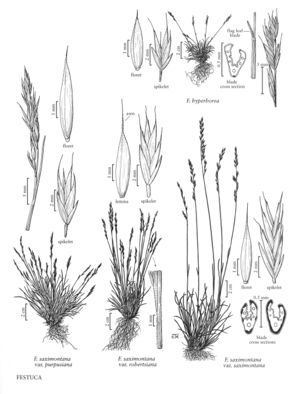Difference between revisions of "Festuca hyperborea"
FNA>Volume Importer |
GeoffLevin (talk | contribs) m (Fixed hyphenation in description.) |
||
| (9 intermediate revisions by 2 users not shown) | |||
| Line 4: | Line 4: | ||
|publications= | |publications= | ||
|common_names=Northern fescue | |common_names=Northern fescue | ||
| + | |special_status={{Treatment/ID/Special_status | ||
| + | |code=E | ||
| + | |label=Endemic | ||
| + | }} | ||
|basionyms= | |basionyms= | ||
|synonyms= | |synonyms= | ||
| Line 13: | Line 17: | ||
}}<!-- | }}<!-- | ||
| − | --><span class="statement" id="st-undefined" data-properties=""><b>Plants </b>densely cespitose, | + | --><span class="statement" id="st-undefined" data-properties=""><b>Plants </b>densely cespitose, without rhizomes. <b>Culms</b> 5-15(20) cm, up to twice as tall as the vegetative shoot leaves, usually erect, sometimes semi-prostrate, glabrous, smooth. <b>Sheaths</b> closed for about 1/2 their length, glabrous, persistent; collars glabrous; ligules 0.1-0.5 mm; blades 0.5-1 mm in diameter, conduplicate, often curved or somewhat falcate, abaxial surfaces smooth or sparsely scabrous, adaxial surfaces scabrous, veins 5-7, ribs 3-5; abaxial sclerenchyma in 3-7 strands, usually less than twice as wide as high; adaxial sclerenchyma absent. <b>Flag</b> leaf sheaths usually somewhat inflated; flag leaf blades 0.5-5(8) mm. <b>Inflorescences</b> 1-2(2.5) cm, contracted, usually panicles, sometimes racemes, with 1-2 branches per node; branches erect, lower branches usually with 1-2 spikelets, sometimes more. <b>Spikelets</b> (3)4-5.5(7) mm, with 3-4(6) florets. <b>Glumes</b> exceeded by the upper florets, ovate to ovate-lanceolate, mostly glabrous and smooth, sometimes scabrous distally; lower glumes 1-3.5 mm; upper glumes 2.2-3.2 mm; lemmas 2.9-3.5(4.4) mm, ovate, apices scabrous and minutely bidentate, awns (0.5)1.4-2(3) mm, usually slightly subterminal, curved or slightly twisted; paleas about as long as or slightly longer than the lemmas, intercostal region smooth or scabrous distally; anthers 0.4-0.8(1.1) mm; ovary apices glabrous. <b>2n</b> = 28.</span><!-- |
-->{{Treatment/Body | -->{{Treatment/Body | ||
| − | |distribution=Greenland;Nfld. | + | |distribution=Greenland;Nfld. and Labr. (Nfld.);N.W.T.;Nunavut;Que.;Yukon |
| − | |discussion=<p>Festuca hyperborea is a high arctic species that grows from Banks Island in the Canadian Arctic east to Greenland and south to Quebec. It differs from F. brachyphylla (p. 428) in its semi-prostrate habit, the loose sheaths and short blades of its flag leaves, the more pronounced ribs in its lower leaf blades, and its subterminal awn. It differs from F. edlundiae (see next) in having flag leaf blades shorter than 5 mm and smaller spikelets. It has frequently been included in F. ovina (p. 422).</p> | + | |discussion=<p><i>Festuca hyperborea</i> is a high arctic species that grows from Banks Island in the Canadian Arctic east to Greenland and south to Quebec. It differs from <i>F. brachyphylla</i> (p. 428) in its semi-prostrate habit, the loose sheaths and short blades of its flag leaves, the more pronounced ribs in its lower leaf blades, and its subterminal awn. It differs from <i>F. edlundiae</i> (see next) in having flag leaf blades shorter than 5 mm and smaller spikelets. It has frequently been included in <i>F. ovina</i> (p. 422).</p> |
|tables= | |tables= | ||
|references= | |references= | ||
| Line 26: | Line 30: | ||
-->{{#Taxon: | -->{{#Taxon: | ||
name=Festuca hyperborea | name=Festuca hyperborea | ||
| − | |||
|authority=Holmen ex Fred. | |authority=Holmen ex Fred. | ||
|rank=species | |rank=species | ||
| Line 33: | Line 36: | ||
|basionyms= | |basionyms= | ||
|family=Poaceae | |family=Poaceae | ||
| − | |distribution=Greenland;Nfld. | + | |illustrator=Cindy Roché |
| + | |illustration copyright=Utah State University | ||
| + | |distribution=Greenland;Nfld. and Labr. (Nfld.);N.W.T.;Nunavut;Que.;Yukon | ||
|reference=None | |reference=None | ||
|publication title= | |publication title= | ||
|publication year= | |publication year= | ||
| − | |special status= | + | |special status=Endemic |
| − | |source xml=https:// | + | |source xml=https://bitbucket.org/aafc-mbb/fna-data-curation/src/200273ad09963decb8fc72550212de541d86569d/coarse_grained_fna_xml/V24/V24_614.xml |
|subfamily=Poaceae subfam. Pooideae | |subfamily=Poaceae subfam. Pooideae | ||
|tribe=Poaceae tribe Poeae | |tribe=Poaceae tribe Poeae | ||
| Line 47: | Line 52: | ||
}}<!-- | }}<!-- | ||
| − | -->[[Category:Treatment]][[Category:Festuca sect. Festuca]] | + | --> |
| + | [[Category:Treatment]] | ||
| + | [[Category:Festuca sect. Festuca]] | ||
Latest revision as of 12:24, 29 April 2022
Plants densely cespitose, without rhizomes. Culms 5-15(20) cm, up to twice as tall as the vegetative shoot leaves, usually erect, sometimes semi-prostrate, glabrous, smooth. Sheaths closed for about 1/2 their length, glabrous, persistent; collars glabrous; ligules 0.1-0.5 mm; blades 0.5-1 mm in diameter, conduplicate, often curved or somewhat falcate, abaxial surfaces smooth or sparsely scabrous, adaxial surfaces scabrous, veins 5-7, ribs 3-5; abaxial sclerenchyma in 3-7 strands, usually less than twice as wide as high; adaxial sclerenchyma absent. Flag leaf sheaths usually somewhat inflated; flag leaf blades 0.5-5(8) mm. Inflorescences 1-2(2.5) cm, contracted, usually panicles, sometimes racemes, with 1-2 branches per node; branches erect, lower branches usually with 1-2 spikelets, sometimes more. Spikelets (3)4-5.5(7) mm, with 3-4(6) florets. Glumes exceeded by the upper florets, ovate to ovate-lanceolate, mostly glabrous and smooth, sometimes scabrous distally; lower glumes 1-3.5 mm; upper glumes 2.2-3.2 mm; lemmas 2.9-3.5(4.4) mm, ovate, apices scabrous and minutely bidentate, awns (0.5)1.4-2(3) mm, usually slightly subterminal, curved or slightly twisted; paleas about as long as or slightly longer than the lemmas, intercostal region smooth or scabrous distally; anthers 0.4-0.8(1.1) mm; ovary apices glabrous. 2n = 28.
Distribution
Greenland, Nfld. and Labr. (Nfld.), N.W.T., Nunavut, Que., Yukon
Discussion
Festuca hyperborea is a high arctic species that grows from Banks Island in the Canadian Arctic east to Greenland and south to Quebec. It differs from F. brachyphylla (p. 428) in its semi-prostrate habit, the loose sheaths and short blades of its flag leaves, the more pronounced ribs in its lower leaf blades, and its subterminal awn. It differs from F. edlundiae (see next) in having flag leaf blades shorter than 5 mm and smaller spikelets. It has frequently been included in F. ovina (p. 422).
Selected References
None.
